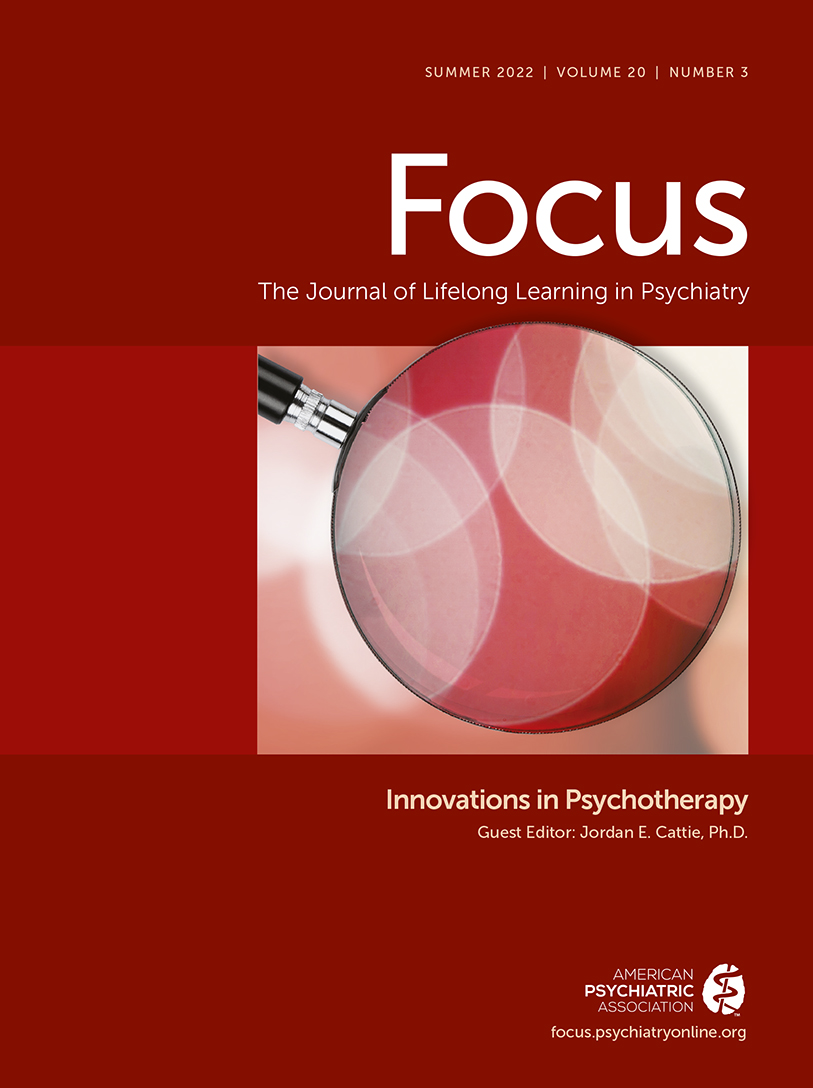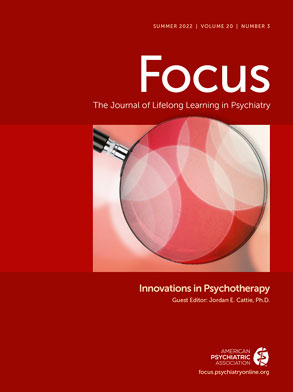When patients have multiple fear-based disorders, how can we prioritize or integrate exposure-based therapies?
Similar to other public health crises in the past, the COVID-19 pandemic has led to an increase in certain salient anxiety and obsessive-compulsive disorder (OCD) themes, including health anxiety, contamination fears, harm by neglect, and somatic experiences (
1,
2). Since the onset of the pandemic, there has been an increased incidence of patients presenting with new-onset or newly exacerbated anxiety symptoms, which, in combination with pre-existing conditions, ultimately increases the number of individuals presenting to clinics with multiple fear-based disorders. Clinicians are often called upon to make decisions about how to distinguish between and prioritize multiple targets for evidence-based treatment using exposure-based therapies.
Review of Exposure Therapy Rationale and Implementation
Exposure therapy is an evidence-based and effective behavioral intervention for many fear-based disorders, including panic disorder, specific phobias, OCD, posttraumatic stress disorder (PTSD), and social anxiety. Client presentations that lend themselves most readily to exposure therapy techniques are usually those for which fear- or anxiety-related distress is central and formed or maintained by classical or operant conditioning. For example, clients may escape anxiety through passive or active avoidance behaviors (e.g., intentional distraction from thoughts, compulsive washing) or attempt to reduce the severity of anxiety through safety behaviors (e.g., researching symptoms, monitoring vital signs with smartwatches, over washing, seeking reassurance of safety). Avoidance behaviors are then negatively reinforced by the temporary relief of anxiety or perception of control.
Exposure therapies involve repeatedly approaching fear-provoking stimuli in real life (in vivo), imagination (imaginal), or bodily sensations (interoceptive). The inhibitory model of extinction proposes that exposure facilitates development of new and generalizable nonthreat associations with the feared stimuli (
3,
4). By encountering new information through exposure trials, patients learn that feared consequences are unlikely to happen and that distress is tolerable (
5,
6). The efficacy and generalizability of exposure is increased when exposures are varied in type and context, emphasis is placed on fear tolerance (i.e., my emotions aren’t dangerous; I can do things even with anxiety) rather than reduction (i.e., my anxiety is lower; I feel better), and retrieval cues for new learning are made in relation to and accessible in many contexts of everyday living.
All exposure therapies share key features, including planned encounters with imagined or real feared stimuli, repeated exposure practice, elimination or reduction of previously reinforced responses, and processing new evidence that violated client expectancies. For example, prolonged exposure (PE) for PTSD utilizes imaginal exposure to a patient’s trauma memory and in vivo exposure to trauma-related cues and avoided situations to promote the reduction of intrusive symptoms maintained by avoidance (
7). Exposure and response prevention (ERP) for OCD and anxiety disorders utilizes many types of exposure to upsetting thoughts, images, stimuli, or situations while the patient resists performing behaviors that reduce or relieve anxiety. Interoceptive exposure for panic disorder involves purposefully generating and allowing physiological sensations deemed intolerable or associated with a feared outcome.
Functional Assessment to Identify Targets
Clinicians who do not routinely offer exposure therapy may feel unsure about how to proceed in treatment planning and referral with multiple targets. However, all clinicians who are familiar with cognitive-behavioral therapy can complete a robust functional assessment to help identify key targets and guide next steps. Functional assessment involves thoroughly assessing antecedents (fear cues), cognitions, behaviors (e.g., avoidance; seeking information or certainty, repetitive or rule-bound behaviors; mental behaviors to neutralize, rationalize, distract, or otherwise experientially avoid), and their consequences (i.e., workability in context, what the behaviors aim to “help with” and how successful they are in the patient’s environment). Together, this information elicits the function of each behavior and its relationship with the patient’s core fears (
4). Exposure therapy can then be used to target each core fear by creating opportunities for learning related to the function identified.
Prioritizing Targets for Exposure
When prioritizing targets for exposure, clinicians might consider the following: What is most severe or impairing (e.g., avoidance that interferes with important activities of living)? What is the client most willing to address at the time (e.g., targets that feel challenging but manageable)? What are the most values-consistent areas for the client (e.g., likely to be reinforcing if reducing avoidance in that area enables engagement in important behaviors that were not possible because of anxiety)? Sometimes, separate components might be identified that can be addressed sequentially, especially if a patient is unwilling to work on certain targets initially. Other times, the patient’s functional assessment results and willingness indicate that a more integrated transdiagnostic approach (
8) would be useful.
Take, for example, a patient presenting with co-occurring health anxiety and PTSD. The functional assessment indicates that significant practice with interoceptive exposures (practice targeting previously avoided physical sensations) is critical to violate fears or expected outcomes that physical sensations are intolerable, never ending, and predictive of death. The functional assessment also indicates that the patient exhibits health- and illness-related fears and avoidance, trauma-related avoidance of memories and reminders, and broader patterns of avoiding strong emotions generally.
In this example, targeting health anxiety first would reduce or eliminate behaviors that function to increase attention or overresponding to normal ranges of bodily sensations. Through interoceptive exposures, the patient will learn that they can experience unwanted, fear-provoking sensations and continue engaging in valued action. Subsequently broadening to exposures that provoke strong emotions that have been avoided by the patient would reduce anxious and avoidant reactions to emotions and promote adaptive assessment of the threat of negative emotions more generally. After having these foundational skills, incorporating exposure to trauma memories and reminders may be more effective and tolerable. Patients may be more willing to work on additional symptoms once they have developed an experiential understanding of exposure therapy, confidence in their own ability to complete it, and trust in their provider or team. At this stage, trauma treatment would also provide additional context to continue practicing coping with body changes due to anxiety and difficult emotions.
Conclusions
Patients presenting with multiple fear-based targets are increasingly likely in the wake of the pandemic. The aforementioned example illustrates how somatic anxiety and panic are often experienced as prominent and distressing, and interoceptive and in vivo exposures can be a framework for learning basic skills that can then be applied to other targets amenable to exposure. Multiple targets can be effectively assessed and treated using evidence-based exposure therapies, either in an integrated or in a sequential manner. Functional assessment can be used to identify targets. Factors such as symptom severity, client willingness, and value congruence can help guide a collaborative discussion about prioritizing and combining exposure targets.

